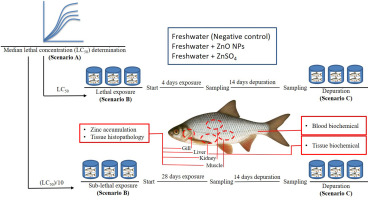Science of the Total Environment ( IF 8.2 ) Pub Date : 2018-01-12 , DOI: 10.1016/j.scitotenv.2018.01.085 K. Khosravi-Katuli , G. Lofrano , H. Pak Nezhad , A. Giorgio , M. Guida , F. Aliberti , A. Siciliano , M. Carotenuto , E. Galdiero , E. Rahimi , G. Libralato

|
Most studies investigating the toxicity of zinc oxide nanoparticles (ZnO NPs) focused on the effect of size, whereas exposure concentration and duration remained poorly understood. In this study, the effect of acute and sub-acute exposures of ZnO NPs on Zn compartmentalization and biomarkers' expression were investigated in Rutilus rutilus caspicus (Caspian roach) considering various exposure scenarios: i) the assessment of the concentration-response curves and median lethal concentration (LC50); ii) the assessment of the effects of organisms exposed at LC50 value and one tenth of LC50 value of ZnO NPs suspensions for 4 d and 28 d, respectively; iii) the assessment of 14 d depuration period. The same concentrations of ZnSO4 were investigated. The highest Zn accumulation was detected in gill after sub-acute exposure (4.8 mg/L; 28 d) followed by liver, kidney and muscle. In gill, liver and muscle, Zn from Zn NPs accumulated higher concentrations. Depuration (14 d) decreased Zn content in each organ, but no complete removal occurred except for muscle. Biomarkers' activity was significantly over expressed after treatments, but depuration brought back their values to background levels and most effects were related to acute concentrations (48 mg/L; 4 d) and in presence of ZnSO4. Histopathological analyses showed that the exposure to ZnO NPs increased lesions in gill, liver and kidney, with a direct proportionality between alterations and Zn accumulated in the target organs. After depuration, lesions regressed for both ZnO NPs and ZnSO4, but not in a complete way. These data could contribute to increase the knowledge about ZnO NPs risk assessment in aquatic vertebrates, suggesting that the size of ZnO NPs can influence biomarker and histopathological effects.
中文翻译:

ZnO纳米粒子在里海蟑螂(Rutilus rutilus caspicus)中的作用。
大多数研究氧化锌纳米颗粒(ZnO NPs)毒性的研究都集中在尺寸的影响上,而对暴露浓度和持续时间的了解仍然很少。在这项研究中,考虑到各种暴露情况,在Rutilus rutilus caspicus(里海蟑螂)中研究了ZnO NPs的急性和亚急性暴露对Zn区划和生物标志物表达的影响:i)评估浓度-响应曲线和中位数致死浓度(LC 50);ii)评估分别暴露于ZnO NPs悬浮液的LC 50值和LC 50值的十分之一分别持续4 d和28 d的生物的影响;iii)评估14 d净化期。相同浓度的ZnSO共调查了4个。亚急性暴露(4.8 mg / L; 28 d)后,g中检出的锌含量最高,其次是肝,肾和肌肉。在g,肝脏和肌肉中,锌纳米颗粒中的锌积累了更高的浓度。净化(14 d)降低了每个器官中的Zn含量,但除肌肉外未发生完全去除。处理后,生物标志物的活性明显过表达,但纯化后将其值恢复至本底水平,大多数影响与急性浓度(48 mg / L; 4 d)和存在ZnSO 4有关。。组织病理学分析表明,暴露于ZnO NPs会增加g,肝和肾中的病变,并且改变与靶器官中所积累的Zn成正比。净化后,ZnO NP和ZnSO 4的病变均消退,但不完全。这些数据可能有助于增加有关水生脊椎动物中ZnO NPs风险评估的知识,这表明ZnO NPs的大小可以影响生物标志物和组织病理学效应。











































 京公网安备 11010802027423号
京公网安备 11010802027423号